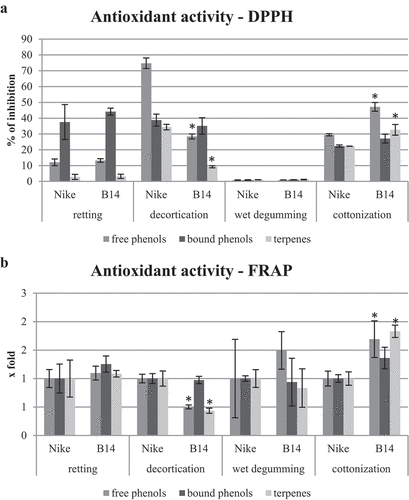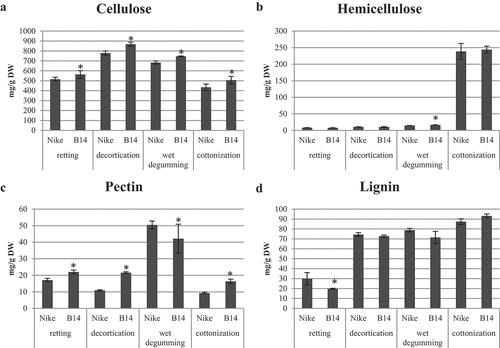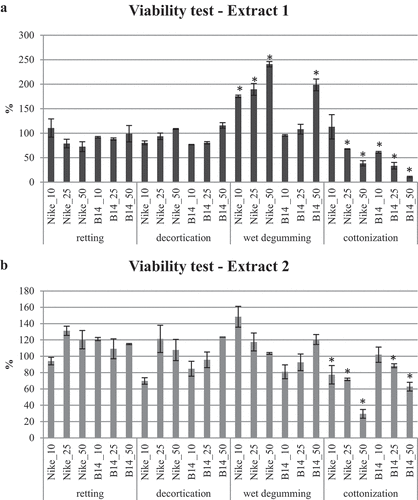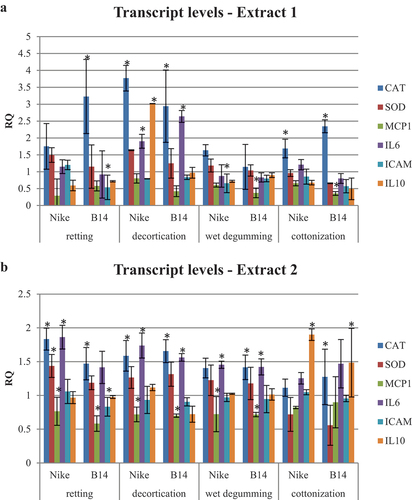Figures & data
Table 1. UPLC separation conditions of phenolic and terpenoid compounds.
Table 2. The content of total free and bound to the cell wall phenolic compounds, terpenoic compounds, and polyamines in fibers obtained by retting, decortication, wet degumming, and cottonization of B14 and Nike flax stems. Data were obtained from the UPLC analysis. Results are mean ± SD (n = 5). Statistically significant changes are marked with asterisks (p < .05). bdl – below detection limit.
Table 3. The content of free phenolic compounds in fibers obtained by retting, decortication, wet degumming, and cottonization of B14 and Nike flax stems. Data were obtained from the UPLC analysis. Results are mean ± SD (n = 5). Statistically significant changes are marked with asterisks (p < .05). bdl – below detection limit.
Table 4. The content of bound to the cell-wall phenolic compounds in fibers obtained by retting, decortication, wet degumming, and cottonization of B14 and Nike flax stems. Data were obtained from the UPLC analysis. Results are mean ± SD (n = 5). Statistically significant changes are marked with asterisks (p < .05). bdl – below detection limit.
Table 5. The content of free polyamines (PA1) conjugated polyamines (PA2) and cell wall-bound polyamines (PA3), including individual polyamines: putrescine, spermidine, and spermine in fibers obtained by retting, decortication, wet degumming, and cottonization of B14 and Nike flax stem. Data were obtained from the UPLC analysis. Results are mean ± SD (n = 4). Statistically significant changes are marked with asterisks (p < .05). bdl – below detection limit.
Figure 1. The antioxidant potential of extracts from fibers obtained by retting, decortication, wet degumming, and cottonization of B14 and Nike flax stems determined by DPPH () and FRAP () methods. Statistically significant changes are marked with asterisks (p < .05).

Figure 2. The content of cell wall polymers (cellulose, lignin, pectin, and hemicellulose) in fibers obtained by retting, decortication, wet degumming, and cottonization of B14 and Nike flax stems. Statistically significant changes are marked with asterisks (p < .05).

Table 6. The content of fatty acids in fibers obtained by retting, decortication, wet degumming, and cottonization of B14 and Nike flax stems. Data were obtained from the GC-FID analysis. Results are mean ± SD (n = 4). Statistically significant changes are marked with asterisks (p < .05).
Table 7. The content of phytosterols in fibers obtained by retting, decortication, wet degumming, and cottonization of B14 and Nike flax stems. Data were obtained from the GC-FID analysis. Results are mean ± SD (n = 4). Statistically significant changes are marked with asterisks (p < .05).
Table 8. The influence of extracts from fibers obtained by retting, decortication, wet degumming, and cottonization of flax stems on microorganisms’ growth was presented as the percentage of non-treated microorganisms (100%) ± standard deviation. Statistically significant changes are marked with asterisks (p < .05).
Table 9. The content of free phenolic compounds in aqueous extract no. 1 from fibers obtained by retting, decortication, wet degumming, and cottonization of B14 and Nike flax stems. Data were obtained from the UPLC analysis.
Table 10. The content of bound to the cell wall phenolic compounds in aqueous extract no. 2 from fibers obtained by retting, decortication, wet degumming, and cottonization of B14 and Nike flax stems. Data were obtained from the UPLC analysis.
Figure 3. The influence of extracts from fibers obtained by retting, decortication, wet degumming, and cottonization of flax stems on fibroblast cell growth presented as the percentage of non-treated fibroblast cells (100%) ± standard deviation. Statistically significant changes are marked with asterisks (p < .05).

Figure 4. Transcript levels of pro-inflammatory (IL6 and MCP1), anti-inflammatory (IL10 and ICAM), and redox (CAT and SOD) genes in the V79 cell line treated with extracts (extract type 1 - 4A and extract type 2 - 4B) containing phenolic compounds from fibers obtained by retting, decortication, wet degumming, and cottonization of flax stems compared to control (untreated cells = 1). Statistically significant changes are marked with asterisks (p < .05).

